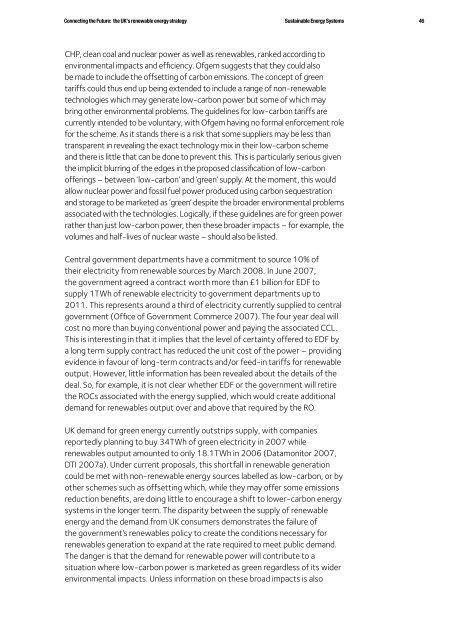Connecting the Future - Greenpeace UK
Connecting the Future - Greenpeace UK
Connecting the Future - Greenpeace UK
You also want an ePaper? Increase the reach of your titles
YUMPU automatically turns print PDFs into web optimized ePapers that Google loves.
<strong>Connecting</strong> <strong>the</strong> <strong>Future</strong>: <strong>the</strong> <strong>UK</strong>’s renewable energy strategy<br />
Sustainable Energy Systems<br />
46<br />
CHP, clean coal and nuclear power as well as renewables, ranked according to<br />
environmental impacts and efficiency. Ofgem suggests that <strong>the</strong>y could also<br />
be made to include <strong>the</strong> offsetting of carbon emissions. The concept of green<br />
tariffs could thus end up being extended to include a range of non-renewable<br />
technologies which may generate low-carbon power but some of which may<br />
bring o<strong>the</strong>r environmental problems. The guidelines for low-carbon tariffs are<br />
currently intended to be voluntary, with Ofgem having no formal enforcement role<br />
for <strong>the</strong> scheme. As it stands <strong>the</strong>re is a risk that some suppliers may be less than<br />
transparent in revealing <strong>the</strong> exact technology mix in <strong>the</strong>ir low-carbon scheme<br />
and <strong>the</strong>re is little that can be done to prevent this. This is particularly serious given<br />
<strong>the</strong> implicit blurring of <strong>the</strong> edges in <strong>the</strong> proposed classification of low-carbon<br />
offerings – between ‘low-carbon’ and ‘green’ supply. At <strong>the</strong> moment, this would<br />
allow nuclear power and fossil fuel power produced using carbon sequestration<br />
and storage to be marketed as ‘green’ despite <strong>the</strong> broader environmental problems<br />
associated with <strong>the</strong> technologies. Logically, if <strong>the</strong>se guidelines are for green power<br />
ra<strong>the</strong>r than just low-carbon power, <strong>the</strong>n <strong>the</strong>se broader impacts – for example, <strong>the</strong><br />
volumes and half-lives of nuclear waste – should also be listed.<br />
Central government departments have a commitment to source 10% of<br />
<strong>the</strong>ir electricity from renewable sources by March 2008. In June 2007,<br />
<strong>the</strong> government agreed a contract worth more than £1 billion for EDF to<br />
supply 1TWh of renewable electricity to government departments up to<br />
2011. This represents around a third of electricity currently supplied to central<br />
government (Office of Government Commerce 2007). The four year deal will<br />
cost no more than buying conventional power and paying <strong>the</strong> associated CCL.<br />
This is interesting in that it implies that <strong>the</strong> level of certainty offered to EDF by<br />
a long term supply contract has reduced <strong>the</strong> unit cost of <strong>the</strong> power – providing<br />
evidence in favour of long-term contracts and/or feed-in tariffs for renewable<br />
output. However, little information has been revealed about <strong>the</strong> details of <strong>the</strong><br />
deal. So, for example, it is not clear whe<strong>the</strong>r EDF or <strong>the</strong> government will retire<br />
<strong>the</strong> ROCs associated with <strong>the</strong> energy supplied, which would create additional<br />
demand for renewables output over and above that required by <strong>the</strong> RO.<br />
<strong>UK</strong> demand for green energy currently outstrips supply, with companies<br />
reportedly planning to buy 34TWh of green electricity in 2007 while<br />
renewables output amounted to only 18.1TWh in 2006 (Datamonitor 2007,<br />
DTI 2007a). Under current proposals, this shortfall in renewable generation<br />
could be met with non-renewable energy sources labelled as low-carbon, or by<br />
o<strong>the</strong>r schemes such as offsetting which, while <strong>the</strong>y may offer some emissions<br />
reduction benefits, are doing little to encourage a shift to lower-carbon energy<br />
systems in <strong>the</strong> longer term. The disparity between <strong>the</strong> supply of renewable<br />
energy and <strong>the</strong> demand from <strong>UK</strong> consumers demonstrates <strong>the</strong> failure of<br />
<strong>the</strong> government’s renewables policy to create <strong>the</strong> conditions necessary for<br />
renewables generation to expand at <strong>the</strong> rate required to meet public demand.<br />
The danger is that <strong>the</strong> demand for renewable power will contribute to a<br />
situation where low-carbon power is marketed as green regardless of its wider<br />
environmental impacts. Unless information on <strong>the</strong>se broad impacts is also




![[2007] EWHC 311 - Greenpeace UK](https://img.yumpu.com/22079793/1/184x260/2007-ewhc-311-greenpeace-uk.jpg?quality=85)











